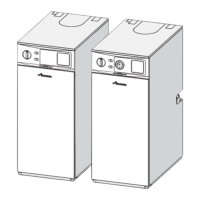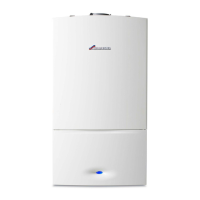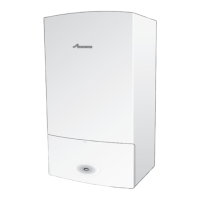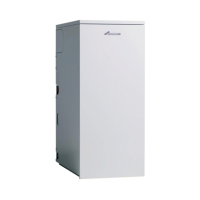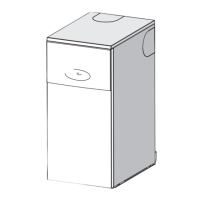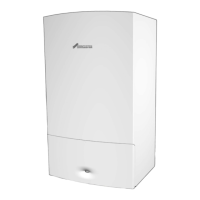Commissioning
Greenstar Danesmoor External
ErP+
and External System
ErP+
6720821725 (2018/04)28
6 Commissioning
6.1 Pre-Commissioning checks - 18/25 Regular shown
▶ Check that the service and water pipes are connected correctly.
▶ Check that all unused sockets are capped.
▶ Check that the oil supply is 28 second kerosene and that the
pipework is connected correctly to the oil pump via the supplied
flexible oil hose [2].
▶ Check that the burner is seated correctly on its mounting flange and
that the oil hose/s are routed correctly.
See page 37, figure 69 for correct routing of the oil hose.
▶ Turn on the main oil supply valve at the tank, check the oil supply
pipework and connections. Rectify any leaks.
▶ Check the flue is correctly fitted and the connections are secure.
▶ Check the condensate pipework [1] is correctly fitted and
connected.
▶ Check the condensate trap is filled with water and discharging
correctly.
Fig. 43 Pre-Commissioning checks
6.2 Filling the system
▶ Open all system and radiator valves.
▶ Turn on the water main stop cock.
▶ Open vented systems only:
– Turn on the water to the system feed and expansion cistern and
allow the system to fill.
▶ Sealed systems only:
– Check and if required, adjust the expansion vessel pressure using
the Schraeder type valve.
▶ Fill the system to between 1 and 2 bar pressure via a WRAS approved
filling link.
▶ Vent all radiators, retighten when completed.
▶ Monitor the pressure gauge during venting and repressurise if
required.
▶ Check the system and correct any leaks.
▶ Bleed air from at least one of the secondary heat exchanger air vents
(a radiator key is ideal for this). There are two venting bosses [1] on
the top of the secondary heat exchanger. Only one can used if fluing
to the side.
Fig. 44 Manual vent points
[1] Manual vent points (each side of the secondary heat exchanger).
6.3 Water treatment
Ensure that the system has been cleaned. Refer to section 4.1.2 of
these instructions.
Flushing (Central Heating)
▶ Ensure the appliance is switched off.
▶ Open all drain cocks and drain the system while the appliance is hot.
▶ Close drain cocks and add a suitable flushing agent at the correct
strength for the system condition in accordance with the
manufacturer's instructions.
▶ Run the appliance/system at normal operating temperature for the
time stated by the manufacturer of the flushing agent.
▶ Drain and thoroughly flush the system to remove the flushing agent
and debris.
Inhibitor (Central Heating)
▶ Check drain cocks are closed and all radiator valves are open before
adding a suitable inhibitor or combined inhibitor/anti-freeze, if the
system is exposed to freezing conditions, to the heating system
water in accordance with the manufacturers instructions.
▶ Fill system via a WRAS approved filling loop to between 1 and 1.5
bar.
▶ Vent all radiators; tighten vents when complete.
▶ Re-pressurise if necessary to 1bar.
DANGER: ISOLATE THE 230V ELECTRICITY SUPPLY
▶ Ensure that the supply is safely Isolated and secured
to prevent inadvertent re-connection.
Information on safe isolation can be found in the
Health and Safety Executive guidance HSG85.
Using test equipment approved to GS38 confirm that
the electricity supply is disconnected.
NOTICE: If the boiler is not to be commissioned then:
▶ After successfully completing all of the checks and any
rectification work, close the water valves, shut off the
oil supply and electrically isolate the boiler.
▶ Complete the installation part of the Guarantee
Registration Card, and complete a CD10 or equivalent
to inform the LABC of the installation.
▶ Refit the top panel.
6720809437-24.1Wo
1
2
NOTICE:
▶ Salt based, softened water must not be used to fill
the central heating system.
The pH value of the system water must be between 6.5
and 8 or the appliance warranty will be invalidated.
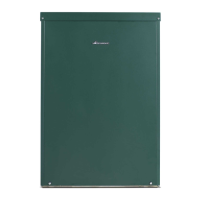
